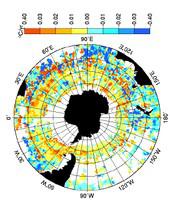The expanse of ocean south of 30S, known as the Southern Ocean, has undergone significant warming since the 1950s. This warming could be a sign of increased poleward eddy heat transport or of a poleward displacement of the entire Antarctic Circumpolar Current (ACC), possibly in response to a decadal-scale southward displacement in the winds that drive the system. The long-term warming trend suggests the possibility that more (or warmer) Upper Circumpolar Deep Water may be coming into contact with the Antarctic Ice Shelves, particularly in regions where the southern edge of the ACC is closest to the Antarctic continent (i.e. particularly in the eastern Pacific, between 140W and 50W, near Pine Island Glacier.) Data from autonomous profiling floats and from satellite altimeters, along with an assimilating model of the Southern Ocean, are important tools for deciphering how the ACC has changed over time and how its changes might influence the oceanic heat budget near Antarctica.
-

- Long-term warming trends in the Southern Ocean at ~900 m depth

